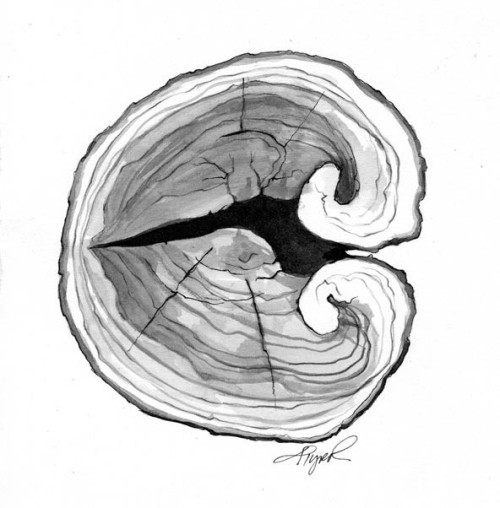
A few weeks ago, I was working outside during one of winter’s warm spells. The sun shone, and the temperature was in the low 40s. From the edge of the woods, a hopeful chickadee sang out, “phEE-bee, phEE-bee, phEE-bee.” Winter was taking a breather.
After sunset, a weather front roared in with a bite. The temperature dropped quickly. I was hurrying to complete my work before dark, and the birds were drifting off to find shelter for the night, when a resonant “CRACK” rang out from the forest.
Somewhere on the steep riverbank a tree’s bark had split and formed a vertical frost-crack along a length of the trunk. During mild, sunny winter weather, sunshine can warm the bark on the south and southwest sides of a tree up to 60 degrees F. If the temperature then drops too quickly, water in the wood and inner bark freezes and expands, causing the bark to split, often with a loud report, frequently causing damage beyond the bark to the cambium layer.
Rooted in place and unprotected from the vicissitudes of nature’s harshest season, it’s a wonder that trees survive. Bark, alone, is no shield against sub—zero temperatures. An over-wintering tree’s situation is not unlike that of a cold-blooded animal, or an insect, which also generates no heat of its own. Spring peepers are a good example. As cold weather descends, water exits their cells, and the fluid that remains is largely glucose, which acts as a natural anti-freeze.
Similarly, as autumn begins and daylight hours are fewer, the membranes that surround the cells in tree tissues start allowing water to pass through more freely. The water migrates out of the cells and into the spaces between. Gradually, this water exerts pressure against the cell walls, but this pressure is offset as cells shrink and occupy less space.
As the water exits, cellular fluid becomes concentrated with natural sugars, proteins and organic acids. This lowers the freezing point of the material in the cells, but not of the water in between. Eventually, as the weather becomes colder, ice crystals form between the cells and the expanding ice pushes in on the cell membranes, but doesn’t puncture them. So the tissues survive.
Different types of trees thrive, or survive, at various northern latitudes depending in part on extreme winter temperatures. Sugar maple and black cherry generally can survive in temperatures to about –45 degrees F, and yellow birch and white ash to nearly 50-below. Other species, such as eastern hemlock, white spruce, eastern cottonwood and northern white cedar (arbor vitae), have been shown in experiments to have a remarkable cold tolerance far beyond temperatures they experience in nature. At the extreme are paper birch, balsam poplar, quaking aspen, balsam fir and basswood, which could tolerate temperatures at or below –112 degrees F.
Species with broad geographical ranges, such as red maple and American sycamore, can survive various temperatures, depending on the climate where they grow. White pine in Tennessee dies when exposed to below –38 degrees F, but tests have shown that some white pines growing in Minnesota could endure down to –128 degrees F. At these extremes, even the minute amount of water remaining in the cells of a tree’s tissues finally experiences a deadly freeze. Alternatively, so much water migrates outside the cells that the cells die of dehydration, or the organic substances that remain inside become concentrated to the point of toxicity.
Still, during most winters, trees are threatened most when the speed and magnitude of temperature changes swing widely. If autumn temperatures drop gradually, a tree’s cell membrane can adapt to the changes. If an early, sudden cold snap appears before sufficient water has exited the cells, then the fluid within can freeze, expand and burst the cell membranes, killing buds, twigs and needles. On any given winter day, trees can cope with a temperature drop (from the freezing point) of as much as 20 degrees in an hour’s time.
Winterkilled needles on pine, hemlock, spruce and arbor vitae turn reddish-brown. Damage on deciduous trees may not show up until the growing season, when buds turn brown and leaves don’t form, or when twigs die in the springtime.
There isn’t much we can do to help wild trees survive the winter. There are, however, a few techniques to assist prized specimen trees to enter dormancy safely and survive until springtime, such as watering evergreens well in late autumn, wrapping the trunks of smooth-barked trees with burlap and refraining from fertilizing trees after late summer, which would encourage a late-growth spurt.
Now that we are deep into March, daytime temperatures are mostly above freezing. Sugar maples and other trees have broken their dormancy and their roots are taking up water from the soil. During the day, when sap begins to flow, some of it drizzles out of taps and into buckets or tubing. Farmers will collect the sap and boil it down to the elixir of the North Country. The delectable maple syrup that eventually tickles our taste buds may seem sweeter when we consider that the sugars we enjoy have helped the trees to survive the past winter’s Arctic blasts.

